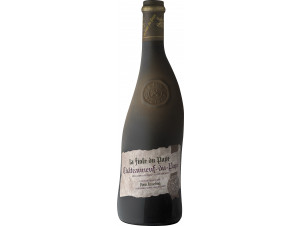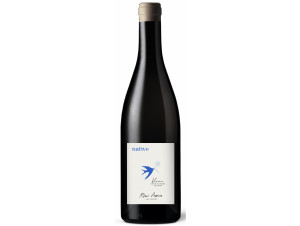You have no items in your shopping cart.
Wine Vallée du Rhône
-
Top Selling-21%
-
Top Selling
-
Top Selling
- -31%
- -21%
- -15%
- -15%
- -22%
- -15%
- -30%
- -20%
Rhône Valley Wines, from Antiquity to Today
The Rhone Valley is one of the oldest French vineyards. Going bac in time, we find the first traces of this vineyard privileged by the Greeks who had settled in Gaul. The Rhone Valley was then the best passage between Europe and the Mediterranean countries, as well as between the Atlantic and Northern Europe. At that time, trade was flourishing and wine was not only appreciated but also valued by the people.
The Villa du Mollard, located near Donzère in the Drôme, was the most important winery in the region. Dating between the 50's and 80's A.D., the Villa du Mollard had an annual production of 2500 hectoliters of wine. To compete with the exploitation, the Romans then created a vineyard whose fame became just as important: Vienna.
In the Middle Ages, the Knights Templar planted the first vines of Châteauneuf-du-Pape, and it was in the 14th century, after the installation of the popes in Avignon, that John XXII had a crenellated fortress built giving the city its name. They then recovered some plots of land abandoned by the Templars and planted the very first papal vineyards. It was not until 1344 that the first known terroir of the city was listed, under the pontificate of Pope Clement VI. Urbain V, the sixth pope of Avignon, planted Muscat grapes before his departure to Rome. During his stay in Italy, he supplied the Roman Court with wines of Saint-Gilles which was the property of the Grand Priory of the Hospitaliers of Saint John of Jerusalem.
In 1731, a regulation came to protect the reputation of the vineyard thanks to strict production rules and the letters "CDR" meaning "Côtes Du Rhône" affixed to the barrels. This did not prevent the vines from suffering from phylloxera in 1860 before starting again with Baron Le Roy who owned Châteauneuf-du-Pape during the 1930s. He was also one of the precursors of the appellation we all know, AOC - Appellation d'Origine Contrôlée.
Nowadays, the wines of the Rhone Valley are among the most appreciated wines in the hexagon, along with the wines of the Bordeaux region.
The Geography of the Rhone Valley
Stretching over two areas between Vienne and Avignon, the northern Rhône valley and the southern Rhône valley are spread over several departments: the Loire, Ardèche, Gard, we speak then of the right bank, and Vaucluse, Rhône and Drôme which are on the left bank. Thus the Rhone Valley is present in the three French regions of Occitania, Auvergne-Rhône-Alpes and Provence-Alpes-Côte d'Azur.
The Rhone Valley covers more than 79 hectares, spread over 1317 communes and has 6,000 farms, a third of which are independent wineries. Because of its size and its high production, the Rhone Valley is the second largest vineyard in France, just behind the Bordeaux area. In fact, nearly 3.5 million hectoliters are harvested each year, representing about 200 million bottles sold per year.
An Ideal Climate for Rhone Valley Wines
. Being spread over several relatively different locations, the Rhone Valley has the particularity of having several different climates. The northern Rhone valley, located in the more mountainous part, has a temperate climate with continental influence, while in the southern Rhone valley the climate is rather Mediterranean, taking advantage of the Mistral wind to preserve a good state of health of the vineyards. We must not forget the high valley of the Drôme where the climate is mountainous and cold, influenced by the high altitude. The most favorable climate for the vineyards is the Mediterranean climate, although it has its weaknesses in periods of drought and heat waves. When the vineyards are located in a region where the climate is rather mountainous, it is necessary to take care to plant the vines on the slope most exposed to the sun.The Importance of Soils in Rhone Valley Wines
Here again, not one but two areas must be taken into account. In the northern Rhone valley, the slopes are very steep and the soils are composed of schist and granite. In the southern Rhone valley, the soils are more varied. Depending on the location, one can find clayey and gravelly soils, terraces of rolled pebbles or molasses soils and sand. As for the Drôme valley located east of Montélimar, the soils there are rather calcareous, mainly due to the mountain rocks found in the area.Rhône Valley Grape Varieties
According to the regulations in place, the appellation côtes-du-Rhône authorizes 21 grape varieties, 8 whites and 13 blacks, either as a main or secondary varieties. The only exception is the small grain muscat which is reserved only for the appellation Beaume-de-Venise. This corresponds to a production distributed as follows: 31% white wine, 60% red wine and 9% rosé wine.
The main grape varieties are syrah, grenache and mourvèdre for the black grape vines, and viognier, white grenache, marsanne, clairette, roussanne and bourboulenc for the white.
The secondary grape varieties include cinsault, counoise, marselan, picpoul, terret, grenache gris, vaccarèse, carignan, muscardin and camarèse for the black grape vines. On the white side, ugni blanc, picpoul blanc and muscat blanc à petit grain are the only three secondary grape varieties found.
The grape varieties of the Rhone Valley have the reputation of being rather vigorous. Most of them flower in June and ripen around September 15th.
Rhône Valley Wine Tasting
Depending on the grape variety, the different aspects and particularities of the wine vary. The red wines of the Rhone Valley are quite powerful with a particularly dark robe. With Syrah for example, one obtains a robe with purplish reflections while with Carignan or Cinsault one will have rather a garnet robe. With white varieties, we see a golden robe that is most often cited with the straw yellow.
On the olfactory level, we find two aspects quite regularly in the red wines of the Rhone Valley: the spicy side and the fruity side. It is often the black fruits and the red fruits that stand out, associated with the powerful side of spices. For the white wines of the region, they tend to be rather floral and fruity..
On the palate, some red wines from the Rhone Valley are quite structured, notably the Beaume de Venise, but we also find softer and more tender wines with Grenache and Syrah grapes. The white and rosé wines are quite fruity, they retain their elegance and their citrus note once in mouth.
The sparkling wines that are produced in the Rhone Valley have relatively fine bubbles, a rather fruity and floral nose like the Clairette de Die for example. They also have the reputation of being quite lively on the palate, bringing out aromas of light flesh fruits such as peach or pear.
The Appellations of the Rhone Valley wines
AOC Châteauneuf-du-Pape
The Châteauneuf-du-Pape is mainly produced in the town whose name it proudly bears, as well as in the communes of Sorgues, Orange, Bédarrides and Courthézon. It is a top-of-the-range wine, one of the greatest French vintages, whose main grape variety is grenache noir. Quite powerful and full-bodied, it is often recommended to be served with red meats in sauce but also with game in gastronomic and traditional restaurants.AOC Crozes Hermitage
The vineyard of Crozes Hermitage is located on the left bank of the Rhône, between Vienne and Valence. Elaborated from Syrah for the reds and from Roussanne and Marsanne for the whites, it represents the largest vineyard of the northern domain, its 1800 hectares extending over 11 communes of the Drôme.AOC Côte Rôtie
Located a few kilometers from Lyon, the vineyards of Côte Rôtie have the particularity of being planted almost vertically, with an inclination of up to 60 degrees. With its subtle blend of Viognier and Syrah, the Côte Rôtie is both fine and delicate, with a magnificent ruby robe and a spicy nose with pleasant aromas of black fruits and violets.AOC Clairette de Die
La clairette de Die is a sparkling wine grown in the Drôme valley, on the border of Provence and the Alps. This naturally sparkling wine must be consumed within 3 years after bottling. The Clairette de Die is particularly light as it is only about 7°C, which makes it a perfect wine for summer.AOC Saint Joseph
Produced on the right bank of the Rhône, the vineyards of Saint Joseph extend over 26 communes of the Loire and Ardèche rivers. The Saint Joseph was a wine very appreciated by the kings of France in the 16th century and is still appreciated today with more than 35 000 hectoliters produced per year.AOC Gigondas
The gigondas offers red wines with aromas of red fruits and truffle as well as rosés with spicy notes. Cultivated near the city of Orange, the vineyards take advantage of the roots offered by the dentelles de Montmirail to feed themselves.AOC Tavel
The great particularity of this wine is that it exists only in rosé. Powerful and complex, Tavel is mainly composed of black Grenache to which we add cinsault, clairette, syrah or picpoul. With its salmon color and almond notes, Tavel is one of the best French rosé wines.How to Accompany the Wines of the Rhone Valley?
For the aperitif, it is advisable to serve Condrieu which is a honeyed white wine with a pale gold robe and aromas of apricot and vine peach.
Depending on whether the starter is based on fish, meat or egg, the food and wine pairing will not be the same. We advise to accompany fish-based starters with a Lirac or a Costières de Nîmes white , snails with a Ventoux and soft-boiled eggs with a Côte du Rhône red to enhance the taste.
White wines such as Châteauneuf-du-Pape, Costières de Nîmes or Côtes du Rhône villages are perfect to accompany steamed fish dishes. On the other hand, for fried fish, a Hermitage or a Saint Joseph is recommended.
With poultry such as chicken or hen for example, we recommend a white Condrieu, a Tavel or a red Côtes du Rhône according to the tastes of each one.
To accompany red meats, a multitude of choices are offered to you. For beef, for example, a Saint Joseph or a Côte Rôtie will be perfect, for exceptional beef, a Chateauneuf-du-Pape or a Strong will sublimate them even more. As for game, it is necessary to serve powerful wines such as Châteauneuf-du-Pape, Côte Rôtie or Gigondas.
Vegetarian or vegan dishes such as vegetable gratins can be accompanied by a Ribs of Die blanc or Vacqueyras. Soups and rosé Gigondas will make a perfect duo, as will vegetable couscous and Tavel.
As far as cheese is concerned, Condrieu or Côte du Vivarais will go perfectly with "soft" cheeses, for cheeses with more character it is better a Rasteau or a Beaume de Venise.
For desserts, Crémant de Die remains the best option because it goes well with all, except for chocolate desserts for which it is better to opt for a Rasteau rosé.
Winemakers
Listed 1421 winemakers
Production
3 million hectolitres per year of red wines, rosés, dry and sparkling white wines, and natural sweet wine.
Area
The Rhone Valley and its rich, complex terroirs. The region is divided into two distinct subregions: Northern Rhone (known as Rhône Septentrional) and Southern Rhone (Rhône Méridional). In the former we find strong wines in beautiful colours with warm, spicy notes, produced by vineyards that stretch 4,700 ha along the Rhone. The latter, with an area of 71,000 ha, is much more important, and this is evident of course in its annual production of red, rosé and white wines quite unlike those of the Northern Rhone.
Soil and subsoil
Hills and plains, clay-limestone. Rich and varied terroir that produces highly distinctive wines.
Grape variety
Reds and rosés : The red wines of the Rhone Valley are quite powerful with a particularly dark robe. There are two aspects quite regularly in the red wines of the Rhone Valley: the spicy side and the fruity side. It is often the black fruits and the red fruit that stand out, associated with the powerful side of spices.
Whites : White varieties of the Rhone Valley produce a golden robe that is most often cited with the straw yellow. For the white wines of this region, their nose tends to be rather floral and fruity and they retain their elegance and their citrus note once in mouth.
Clairette-de-Die
Côtes du Rhône Villages Suze-la-Rousse
Côtes-du-Rhône Villages Sainte-Cécile
Côtes-du-Rhône-Villages Chusclan
Côtes-du-Rhône-Villages Laudun
Côtes-du-Rhône-Villages Massif-d'Uchaux
Côtes-du-Rhône-Villages Plan-de-Dieu
Côtes-du-Rhône-Villages Rochegude
Côtes-du-Rhône-Villages Sablet
Côtes-du-Rhône-Villages Séguret
Côtes-du-Rhône-Villages Signargues
Vin de Pays des Collines Rhodaniennes
Vin de Pays des Collines Rhodaniennes







































 TWIL - Achat de Vin
TWIL - Achat de Vin


